高一英语上册 教学案全套 新人教版必修1
人教版高中英语必修1教案5篇
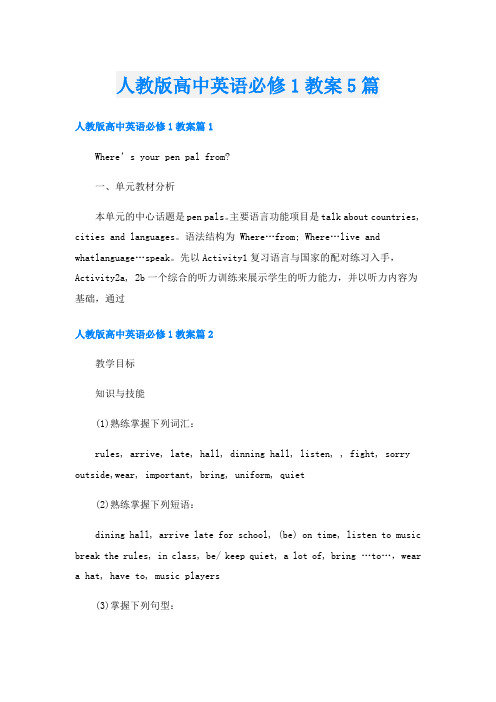
人教版高中英语必修1教案5篇人教版高中英语必修1教案篇1Where’s your pen pal from?一、单元教材分析本单元的中心话题是pen pals。
主要语言功能项目是talk about countries, cities and languages。
语法结构为 Where…from; Where…live and whatlanguage…speak。
先以Activity1复习语言与国家的配对练习入手,Activity2a, 2b一个综合的听力训练来展示学生的听力能力,并以听力内容为基础,通过人教版高中英语必修1教案篇2教学目标知识与技能(1)熟练掌握下列词汇:rules, arrive, late, hall, dinning hall, listen, , fight, sorry outside,wear, important, bring, uniform, quiet(2)熟练掌握下列短语:dining hall, arrive late for school, (be) on time, listen to music break the rules, in class, be/ keep quiet, a lot of, bring …to…,weara hat, have to, music players(3)掌握下列句型:1. Dont eat in class.2. You must be on time.3. Eat in the dining hall.4. 正确使用情态动词can, can’t——Can we wear a hat in school?——Yes, we can./No, we can’t.5. 能正确使用have to 和 must 谈论规章制度We must be on time/ We also have to be quiet in the library. 教学重难点重点:1) 肯定祈使句是省略掉主语的原形动词开头;2) 否定祈使句则是在肯定祈使句前加上“don’t”。
高一英语新人教版必修一Unit1课堂教学方案的详细解读
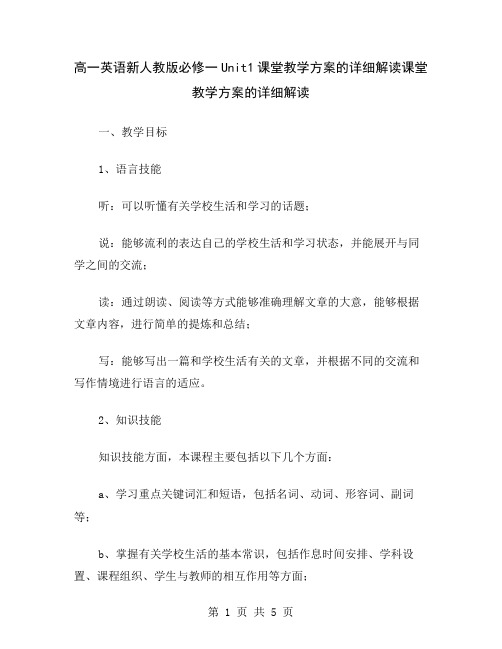
高一英语新人教版必修一Unit1课堂教学方案的详细解读课堂教学方案的详细解读一、教学目标1、语言技能听:可以听懂有关学校生活和学习的话题;说:能够流利的表达自己的学校生活和学习状态,并能展开与同学之间的交流;读:通过朗读、阅读等方式能够准确理解文章的大意,能够根据文章内容,进行简单的提炼和总结;写:能够写出一篇和学校生活有关的文章,并根据不同的交流和写作情境进行语言的适应。
2、知识技能知识技能方面,本课程主要包括以下几个方面:a、学习重点关键词汇和短语,包括名词、动词、形容词、副词等;b、掌握有关学校生活的基本常识,包括作息时间安排、学科设置、课程组织、学生与教师的相互作用等方面;c、理解英语语法中的基础知识,比如时态、从句、倒装语序等;d、通过本单元的学习,进一步加强学生的英汉对照能力、快速阅读能力以及独立思考能力。
二、教学方法本课程的教学方法,将采用多元化的教学方式,其中主要包括以下几个部分:1、交互交流式教学:在教学中,将通过让学生分组,互相进行交流和讨论的形式,帮助学生更好地理解和掌握学习内容。
2、幻灯片展示教学:通过制作和展示相关教学PPT,增强学生的视觉效果,帮助学生快速掌握和理解新的知识点。
3、音频辅助教学:在教学中,将通过播放相关英语听力材料,帮助学生提升听力水平,从而更好地完成本单元各项任务。
4、情景综合教学:将通过学生自己撰写一篇有关学校生活的文章,让他们在具体的语言应用情境中进行综合口语和写作能力的提高。
三、教学内容本单元的主要知识点包括以下几个方面:1、重点词汇与短语掌握本单元词汇主要内容有:校长、教师、学生、图书馆、办公室、讲堂、体育馆、实验室、课程表、第一节、作业、考试、课外活动等。
2、学校常识掌握学生需要了解高中生涯各个方面,包括一学期有多少个学科?一天的课程组织是怎样的?课程与教师之间的作用是怎样的?等等。
通过了解这些内容,学生能够更好的理解和掌握学习内容。
3、英语语法掌握在本单元中,需要学生掌握英语中的基本语法知识,包括句型、时态、语态、从句等知识点。
新人教版高一英语必修一全册学案
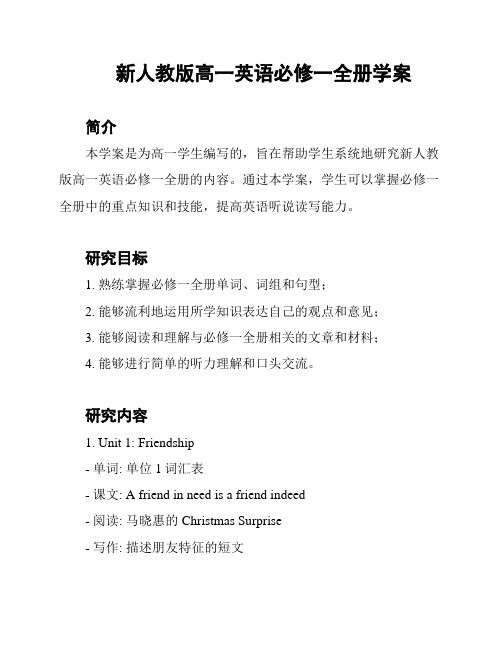
新人教版高一英语必修一全册学案简介本学案是为高一学生编写的,旨在帮助学生系统地研究新人教版高一英语必修一全册的内容。
通过本学案,学生可以掌握必修一全册中的重点知识和技能,提高英语听说读写能力。
研究目标1. 熟练掌握必修一全册单词、词组和句型;2. 能够流利地运用所学知识表达自己的观点和意见;3. 能够阅读和理解与必修一全册相关的文章和材料;4. 能够进行简单的听力理解和口头交流。
研究内容1. Unit 1: Friendship- 单词: 单位1词汇表- 课文: A friend in need is a friend indeed- 阅读: 马晓惠的Christmas Surprise- 写作: 描述朋友特征的短文2. Unit 2: English around the world- 单词: 单元2词汇表- 课文: English is widely spoken- 写作: 介绍英语在全球的使用情况3. Unit 3: Travel journal- 单词: 单元3词汇表- 课文: An exciting trip- 阅读: My unforgettable journey to Australia - 写作: 记叙一次令人难忘的旅行经历4. Unit 4: Music- 单词: 单元4词汇表- 课文: The universal language of music- 阅读: The power of music- 写作: 描述自己对音乐的热爱和体验5. Unit 5: Restaurants- 单词: 单元5词汇表- 课文: Eating out- 阅读: A memorable dining experience- 写作: 描述一次难忘的就餐体验研究活动1. 单词记忆:通过单词卡片、背诵等方式掌握单元中的新词汇和词组;2. 课文阅读:逐段阅读课文,理解文章的主旨和细节;3. 阅读理解:完成与课文相关的阅读理解题,提高阅读理解能力;4. 听力训练:听录音,完成听力题,提高听力理解能力;5. 口语练:与同学进行口语交流,练流利表达自己的观点;6. 写作训练:完成与课文相关的写作任务,提高写作能力;7. 复和测试:定期复所学内容,并进行测试,巩固知识。
高中英语新课标人教版教案必修一
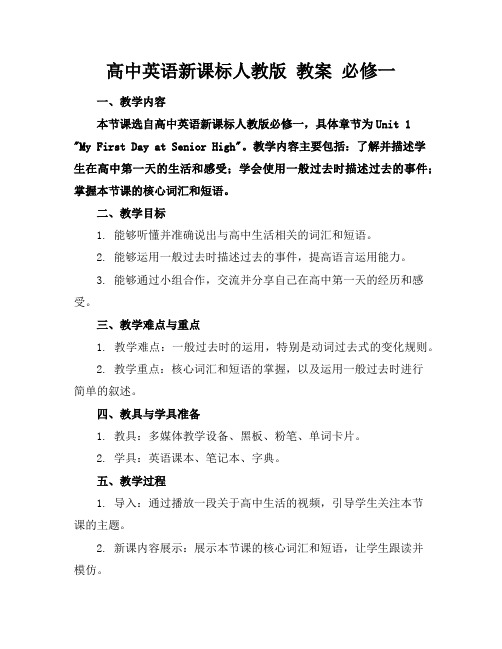
高中英语新课标人教版教案必修一一、教学内容本节课选自高中英语新课标人教版必修一,具体章节为Unit 1 "My First Day at Senior High"。
教学内容主要包括:了解并描述学生在高中第一天的生活和感受;学会使用一般过去时描述过去的事件;掌握本节课的核心词汇和短语。
二、教学目标1. 能够听懂并准确说出与高中生活相关的词汇和短语。
2. 能够运用一般过去时描述过去的事件,提高语言运用能力。
3. 能够通过小组合作,交流并分享自己在高中第一天的经历和感受。
三、教学难点与重点1. 教学难点:一般过去时的运用,特别是动词过去式的变化规则。
2. 教学重点:核心词汇和短语的掌握,以及运用一般过去时进行简单的叙述。
四、教具与学具准备1. 教具:多媒体教学设备、黑板、粉笔、单词卡片。
2. 学具:英语课本、笔记本、字典。
五、教学过程1. 导入:通过播放一段关于高中生活的视频,引导学生关注本节课的主题。
2. 新课内容展示:展示本节课的核心词汇和短语,让学生跟读并模仿。
3. 例题讲解:以"Yesterday was my first day at senior high. I"为例,讲解一般过去时的用法。
4. 随堂练习:让学生运用一般过去时,描述自己在高中第一天的经历。
5. 小组活动:学生分成小组,互相交流并分享自己的经历,提高语言表达能力。
六、板书设计1. 核心词汇和短语:写在黑板的左边,方便学生查看。
2. 一般过去时的结构:写在黑板的右边,突出教学重点。
七、作业设计1. 作业题目:请用一般过去时描述你昨天的一天。
2. 答案示例:Yesterday was my busy day. I got up at 6:00, had breakfast and went to school. In the morning, I had four classes. After lunch, I played basketball with my friends. In the evening, I did my homework and watched TV.八、课后反思及拓展延伸1. 课后反思:本节课学生对于一般过去时的掌握程度较好,但仍有个别学生动词过去式变化不准确,需加强练习。
2020年新人教版高中英语必修一教案全套

2020 年新人教版高中英语必修一教案全套《Welcome Unit》单元教案Welcome Unit Period 1 Listening and Thinking课题Period 1 Listening and Thinking 单元Welcome Unit During this period, the class will focus on listening and thinking.教材Students are expected to get insight into the first day of school.分析The teachers would inspire students to learn how to make introductions and greeti教学1.Learn and master the key words and phrases.目标2.Train thsetudents’ ability to pronunciation and listening.与核3.Enable the students know more about vowels.心素4.Encourage students to learn more about introductions and greetings.养1.Master the usage of key words and phrases.重点2.Improve the students’ listening and s p i e l a i k t i y n.g ab1.Let students pay attention to the pronunciation of vowels.难点2.Make the students know about how to communicate on the first meet.1教学过程教学教师活动学生活动设计意图环节Daily routineStep Warm up - A ctivate1 Teacher greets the whole class as usual. students andremind them toconcentrate. Step Preview c heck Students - C heck the2 Teacher asks students the meaning of wordsa,nswer the teaching situationphrases and knowledge points learnt last l q e u s e s s o t n i.o n sloudlytogether. Lead-in of last lesson quickly.- Help students consolidate the knowledge points.Step 3SayingTeacher shows the pictures to lead the topic.A thousand-mile journey begins with the first step.—Laozi- U se picturesto catch students’attention.- E xpand theirhorizons andspark theirinterest.1.Do you think so?2.What’s your first step?Afteracknowledging3.Do you think the first step is very theimportant?Video: Lost On The First Day Of HighSchoolinformation andthe meaning ofthe new words,answer theStep 4What did the girl experience on the f irs q t uestions. day?What was her feeling?How do you feel on the first day of s chool? Why so?New wordsTeacher explains the meaning of the newwords, and asks students to translate the meaning - Teach themeaning of newwords.of the whole sentence.Step 5exchangeexchange programmeexchange studentslecturesexfemale-malenationnationalitycampusThey wanted to design a machine that was bothattractive and practical.designerHe wrote a very formal letter of apology to Douglas.informal Let’splayTeacher choses students to answer thequestions.1.She lives on (= within themain university area).2.One evening the company arranged adinner after the play.3.We may be able to a course tosuit your particular needs.4.Have you come to at theschool?5.It was a story that touched the- F amiliarizethe new words- Clear the tackle oflistening practice.heart.6.He used to me about getting too much sun.keys:1.campus2. formal3. design4. register5. nation’s6. lectureStep 6Pair workDiscuss the questions in groups.Match the pictures with the s entences.Discuss withtheir patternerand voice their- FamiliarizeStudents with keywords.- M akeA My name is Amy. I'd like to have a s t u o d p e i n n t i o n s I D card,please.B Hi, I'm Max Jackson. I'm an exchangestudent from the UK.C Hello, everyone! Welcome to our school!Describe what the people in the pictures a re doing.Listening & Speaking students use core words and phrases. - Exercise students’ expression and speaking skills.Step Listening practice Listen to the - F amiliarize7 Teacher shows the questions. Then teachemraterials plays thelistening material and asks s t u d c e a n r t e s f u t l o l y and students with key words.answer. do the - E xerciseAmy is getting her student ID card. List l e i n stening to Conversation 1 and complete the table. e xercises. Keys: students’ speaking skills.1. 1701432.Amy Jones3.the USA4.1/One5.amyj16@Max meets Amy in the dining hall. Listen t o Conversation 2 and tick Max's favorite subject and Amy's favorite subject.Keys:1.maths2.chemistryAmy is talking to Ms Li, a school a dviser, about which courses to choose.Listen to Conversation 3 and answer the questions.1.What does Amy want to be in thefuture?A An engineer B. A designer. C A writer.2.What course will Amy probably choose?A EnglishB. IT.Keys:1. BC Art.2. CStep 8People speak insituations.IntroductionsMy name is ...a more polite way in forma S l tudentslisten totips.the- Help students learntips in listeningpractice.- M akeI'm ...This is ...Have you met ...? Doyou know ...?May I introduce ...?I'd like you to meet ...I don't believe you know ...GreetingsHi/Hello! Goodmorning!What's up?How's it going?How are things going? How are you?How are you doing? Nice/Glad to meet you.ResponsesHi/Hey!Morning!Not much.Great!I'm fine, and you? Very well, thank you. How about you?Nice/Glad to meet you, too.Break the ice“Break the ice” is a common English expression. It means “to get comfortable with someone.”students masterthe listening skill better. - Better finish the testing task.After the first greeting, the best way to break the ice is to ask for very basic information. This gives you a reason for starting the conversation.Here are some examples:How are you?Where are you from?What are you doing here? or What brings you here?Are you having a good time?Prepare some basic answers about yourself now, sothat you can introduce yourself with confidence and perfect English in the moment.Keep your answers short and simple so youless timehave less time to make mis—ta a k n e d s tolose so e m one’s attention!E.g.Where are you from?What do you do?What are you doing here?How was your trip?Are you having a good time?What do you think of the weather?Even when questions are specific, you can have a general response prepared. Say something generally positive, then add in more detail.Adding the detail keeps the conversationStep interesting. Then you can ask a question.Discussion Use what - V oice their9Teacher shows the topic and gives studentthsey have opinions.examples to discuss. learnt from the - P ractice theirWork in groups. Choose one of the interview tohelp you andteam spirit.- P ractice theirsituations and make a conversation. Try t o d i u s s c e u s s in thinking skill andthe introductions and greetings b elow.A boy meets a girl during a break. groups. imagination.- P ractice their speaking andAn exchange student is talking to a teacher on campus.A boy and a girl are at the airport to meet a visiting groupof teachers and students from England.listening.StepRole play your conversations or thingshappened on the first day of school!Pronunciation Students do - I mprove the10the exercises.students’Listen and repeat. Notice the pronunciation of the vowels (A, E, I, O, U). Then add a w ord to each group. pronunciation skill./ei/ /x/ grade escape m ap /i:/ /e/ these Chinesecampus met forget/ai/ /I/ w rite /au/ ID/ h ope alive quizalone froglisten coffee/ju:/ ht/use future up discussStep 11 Video: VOWEL SOUNDS Learn therelatedknowledgepoint.- Help studentsunderstand andmaster relatedknowledge points.Step Language points Listen to the - Help s tudents 12 Teacher explains the language points andkey knowledge know about themakes some exercise.1.exchange n.交换;交流vt.交换;交流;交易;兑换I’m an exchange student from the Uk.points carefullyand take exercise.knowledge pointsdeeper.- Let studentsknow how to usethese words andphrases.exchange studen互t派留学生exchange programmes交流项目exchange teacher互s 派教师exchange message交换信息an exchange of glanc交es换眼神an exchange of informati交on换信息in exchange f o用r …交换exchange blows互殴,打起来God offers to exchange what He has for what we have.上帝愿意用他所拥有的来交换我们所拥有的。
人教版高一英语必修一教案

人教版高一英语必修一教案1. 教学目标•掌握必修一单词和词组的基本意思及用法。
•熟练运用必修一相关语法结构。
•提高学生的听说读写能力。
•培养学生的合作意识和学习策略。
2. 教学重点•单词和词组的掌握。
•语法结构的熟练运用。
•阅读和听力能力的培养。
3. 教学难点•高难度词汇和语法的掌握。
•听力和口语能力的提高。
4. 教学准备•教学课件和录音设备。
•学生课本和练习册。
•相关教学资料。
5. 教学步骤第一课时Step 1: 导入新课•利用多媒体展示一些关于旅行的图片和视频,激发学生对旅行话题的兴趣。
Step 2: 课前预习•让学生在课本上阅读第一单元的标题和简介,了解本单元的主题和内容。
Step 3: 听力训练•播放录音,让学生听两段对话并回答相关问题,以培养学生的听力能力。
•把第一单元的单词分发给学生,让他们根据上下文猜测单词的意思,并用这些单词造句。
Step 5: 阅读理解•让学生阅读第一单元的阅读材料,并回答相关问题,以培养他们的阅读能力。
Step 6: 语法讲解•介绍本单元的重点语法结构,并给出例句,让学生理解和模仿。
Step 7: 合作活动•分组让学生完成小组练习,通过合作,加深对单元内容的理解和掌握。
Step 8: 课堂总结•对本节课进行总结和复习,帮助学生巩固所学内容。
第二课时Step 1: 复习导入•利用第一课时的课程回顾,帮助学生回忆所学内容。
Step 2: 口语训练•设计一些关于旅行的情景对话,让学生进行角色扮演,以提高他们的口语表达能力。
Step 3: 阅读拓展•分发相关阅读材料,让学生在限定时间内读完并回答问题,培养他们的阅读理解能力。
Step 4: 语法练习•针对本单元的语法结构进行练习,帮助学生巩固知识点。
Step 5: 听力训练•播放录音,让学生听短文,并回答相关问题,以提高他们的听力水平。
Step 6: 写作训练•布置一篇关于旅行的作文题目,让学生在规定时间内完成并相互交流修改。
高一英语必修一unit1教案
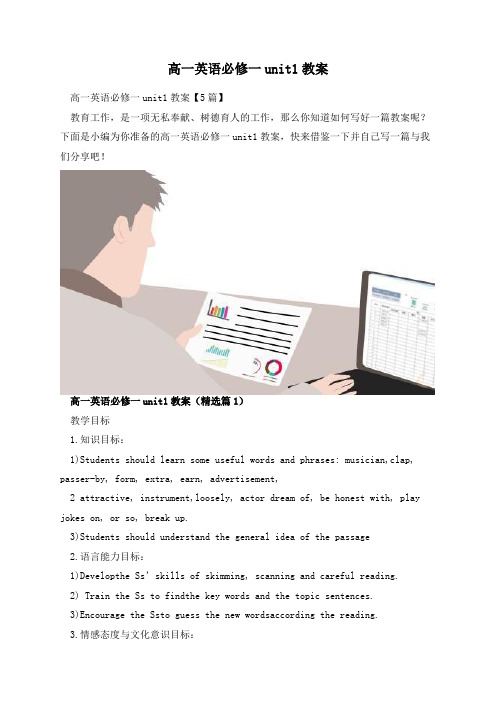
高一英语必修一unit1教案高一英语必修一unit1教案【5篇】教育工作,是一项无私奉献、树德育人的工作,那么你知道如何写好一篇教案呢?下面是小编为你准备的高一英语必修一unit1教案,快来借鉴一下并自己写一篇与我们分享吧!高一英语必修一unit1教案(精选篇1)教学目标1.知识目标:1)Students should learn some useful words and phrases: musician,clap, passer-by, form, extra, earn, advertisement,2 attractive, instrument,loosely, actor dream of, be honest with, play jokes on, or so, break up.3)Students should understand the general idea of the passage2.语言能力目标:1)Developthe Ss’skills of skimming, scanning and careful reading.2) Train the Ss to findthe key words and the topic sentences.3)Encourage the Ssto guess the new wordsaccording the reading.3.情感态度与文化意识目标:1)Encourage the Ss to share the differentkinds of music.2)Improve the cooperation and share among the students.教学重难点1、教学重点:a.To understudend the passage better b.To find the main idea of eachparagraph2、教学难点:a.Master the reading ability b.Develop the skills ofreading 教学过程教学设计本节课共45分钟,具体教学步骤如下:Step I Leading-in播放一段小视频,内容为歌曲 If you arehappy的英文版本,通过介绍演唱乐队twins引出本单元话题。
新课标人教版高中英语必修一全部教学案
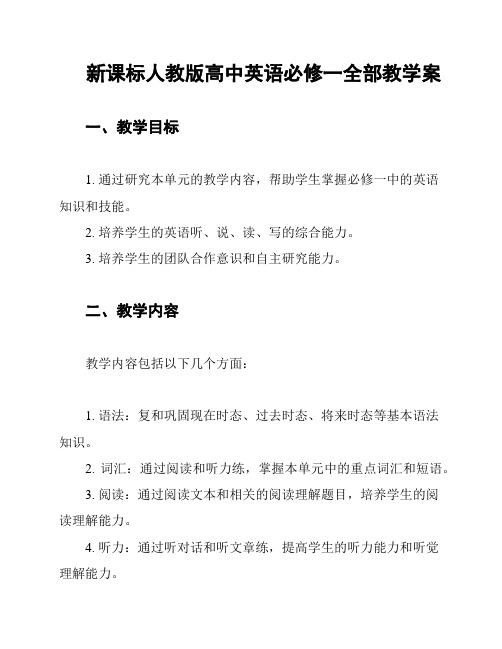
新课标人教版高中英语必修一全部教学案一、教学目标1. 通过研究本单元的教学内容,帮助学生掌握必修一中的英语知识和技能。
2. 培养学生的英语听、说、读、写的综合能力。
3. 培养学生的团队合作意识和自主研究能力。
二、教学内容教学内容包括以下几个方面:1. 语法:复和巩固现在时态、过去时态、将来时态等基本语法知识。
2. 词汇:通过阅读和听力练,掌握本单元中的重点词汇和短语。
3. 阅读:通过阅读文本和相关的阅读理解题目,培养学生的阅读理解能力。
4. 听力:通过听对话和听文章练,提高学生的听力能力和听觉理解能力。
5. 口语:通过各种口语练,提高学生的口语表达能力。
三、教学方法1. 任务型教学法:通过让学生完成一系列任务,激发学生的研究兴趣,加强学生的实际运用能力。
2. 合作研究法:引导学生在小组内进行合作研究,促进学生之间的互动和交流。
3. 归纳法:通过教师引导和学生参与,将教学内容进行总结和归纳,提高学生的研究效果。
四、教学步骤1. 导入:通过引入生活例子或相关资料,唤起学生对新学知识的兴趣。
2. 语法讲解:教师通过讲解和示范,介绍本单元的语法知识。
3. 词汇研究:通过词汇游戏和词汇练,帮助学生记忆和掌握本单元的重点词汇。
4. 阅读训练:教师通过指导学生阅读文本和做阅读理解题目,提高学生的阅读理解能力。
5. 听力训练:教师播放相关听力材料,学生进行听力训练和听觉理解练。
6. 口语练:教师引导学生进行口语练,提高学生的口语表达能力。
7. 总结归纳:教师对本节课的教学内容进行总结和归纳。
8. 作业布置:教师布置相应的作业,巩固学生对本节课的研究。
五、教学评价1. 教师根据学生的课堂表现、作业完成情况和考试成绩等,进行教学评价。
2. 学生之间进行互评,促进学生之间的交流和研究成长。
六、教学资源1. 教材:新课标人教版高中英语必修一教材。
2. 多媒体设备:投影仪、电脑、音响设备等。
3. 课外资料:相关的练册、参考书和教育软件等。
- 1、下载文档前请自行甄别文档内容的完整性,平台不提供额外的编辑、内容补充、找答案等附加服务。
- 2、"仅部分预览"的文档,不可在线预览部分如存在完整性等问题,可反馈申请退款(可完整预览的文档不适用该条件!)。
- 3、如文档侵犯您的权益,请联系客服反馈,我们会尽快为您处理(人工客服工作时间:9:00-18:30)。
必修一Unit 1 Friendship 单元要点预览(旨在让同学整体了解本单元要点)Ⅰ.词语辨析(旨在提供完形填空所需材料)Ⅱ.词性变化(旨在提供语法填空所需材料)Ⅲ.重点词汇(旨在提供综合运用所需材料)1. upset adj. 心烦意乱的,不安的;不适的vt. (upset, upset)[典例]1). Our arrangements for the weekend were upset by her visit. 她一来把我们周末的安排给打乱了。
2). Don't upset yourself -- no harm has been done. 不要难过--并没有造成伤害。
3). He was horribly upset over her illness. 他为她的病而忧心忡忡。
4). The students really upset her. 学生们着实让她烦恼。
[重点用法]be ups et by… 被…… 打乱upset oneself about sth 为某事烦恼[练习] 用upset的适当形式填空1). Is it ______ you, dear?2). She felt rather ______ on hearing the news.3). Is it an ______ message?4). Don’t be ______. It will be OK.答案: 1). upsetting 2). upset 3). upsetting 4).upset2. concern v.担忧; 涉及; 关系到 n. 担心,关注;(利害)关系[典例]1). The news concerns your brother. 这消息与你兄弟有关。
2). The boy's poor health concerned his parents. 那男孩健康状况不佳,使他的父母亲忧虑。
3). That's no concern of mine. 那不关我的事。
[重点用法]as / so far as … be concerned 关于;至于;就……而言be concerned about 关心be concerned at / over sth. 为某事忧虑be concerned in sth. 牵涉到,与……有关,参与[练习] 用concern的适当形式填空1). There is an article that _______ the rise of the prices.2). The children are rather _____ about their mother’s health.3). Officials should ______ themselves _______ public affairs.答案: 1). concerns 2). concerned 3). concern … with3. settle vt. 安家;定居;停留vt. 使定居,安家;解决[典例]1). He settled his child in a corner of the compartment. 他把孩子安顿在车厢的一个角落里。
2). The family has settled in Canada. 这家人已定居加拿大。
3). Both wanted to settle their scores. 双方都愿意捐弃前嫌。
[重点用法]settle down 镇定下来 settle in 在…定居[练习] 中译英1). 都十一点了,她安不下心来工作。
______________________________________________________________________________________ 2). 题目这么难,谁能解决?______________________________________________________________________________________ 答案: 1). It’s eleven o’clock now, but she cannot settle to work.2). Since it is so difficult, who can settle this problem?4. suffer vt.& vi.遭受;忍受;经历[典例]1). Do you suffer from headaches? 你常头痛吗?2). She's suffering from loss of memory. 她患有遗忘症。
[重点用法]suffer from/with/for sth 感到疼痛﹑不适﹑悲伤等; 受苦; 吃苦头:[练习] 中译英1).我们在金融危机中损失惨重。
______________________________________________________________________________________ 2).他的脚痛得不得了。
______________________________________________________________________________________ 答案: 1). We suffered huge losses in the financial crisis.2). He suffers terribly with his feet.5. disagree vt. 不同意[典例]1). Even friends sometimes disagree with each other. 即便是朋友也有时意见不一。
2). We disagreed on future plans. 我们对未来的计划产生了分歧。
[重点用法]disagree with sb/what sb says/sb's decision 不同意某人的观点[某人的话/某人的决定][练习] 中译英1). 罗马的报道与米兰的不符。
______________________________________________________________________________________ 2). 他不同意让我早些回家。
______________________________________________________________________________________ Key: 1). The reports from Rome disagree with those from Milan.2). He disagreed to let me go home early.Ⅳ.重点词组(旨在提供综合运用所需材料)1. add up 加起来[典例]1). Add up your scores and see how many points you can get.把你的得分加起来,看看你能得几分。
2). Tom, what do ten, twenty and five add up to?汤姆,10,20和5加起来是多少?[短语归纳]add (…) to …. (把什么)加入…中add up to … 加起来是[练习] 用add的适当形式或构成的词组填空1). Will you _____ some more students to this project?2). Small numbers _____ a large one.3). 50 _______ 50 equals 100.答案: 1). add 2). add up to 3). added2. go through 经历;经受[典例]1). The country has gone through too many wars. 这个国家经历了太多的战争。
2). She's been through a bad patch recently. 她最近经历了一段困难时期。
[短语归纳]go after追求,追赶go ahead前进;请说(做)吧go by走过,(时间)过去go along with向前,(与……)一起去go in for爱好,从事go out外出;(灯,火)熄灭go over越过;复习go up爬上,(价格等)上升[练习] 用go 构成的词组填空1). It is wise not to ____ with this plan.2). Prices ______ a little now. People are happy.3). Anyway, don’t always_______ at night by yourself.4). I am tired. I want to _____ now.答案: 1). go on with 2). go up 3). go home 4). go to bed3.on purpose 故意,有目的地[典例]The boy broke Jack’s window on purpose. He wanted to frighten Jack.那男孩是故意打破杰克的窗玻璃的,他想吓一下杰克。
[短语归纳]do sth. on purpose: 故意做某事on purpose 表示故意地、有企图、有目的地[练习]用 purpose的相关词汇填空1). He didn’t do it ______.2). What was your ____ ?答案: 1). on purpose 2). purpose4. get along with 与某人相处;(工作的) 进展[典例]1). He is not easy-going. It’s very hard to get along with him 他不是个随和的人,很难相处。
2). How are you getting along with your work? 工作进展如何?[短语归纳]get along/on well/ nicely/ badly with 与……相处得好/不好,……进展顺利/不顺利get away离开,逃离get down下来;写下,取下get down to (doing)开始认真干……get over克服,摆脱get through通过,做完get together聚集[练习] 中译英1). 你现在和同事相处得好不好?______________________________________________________________________________________ 2). 她已重新获得从前那份工作。
